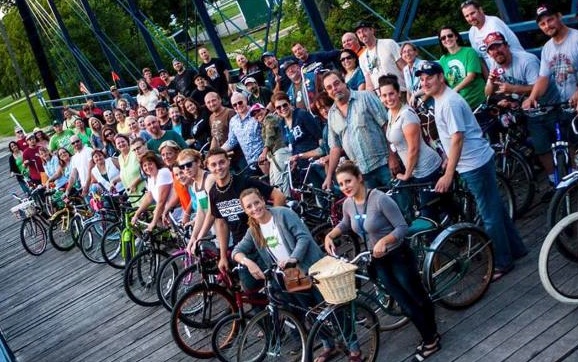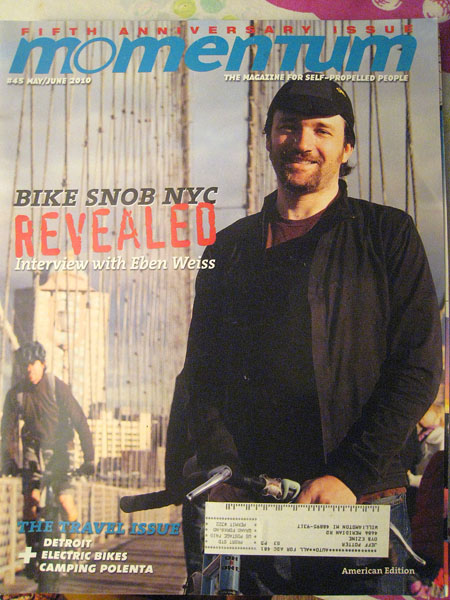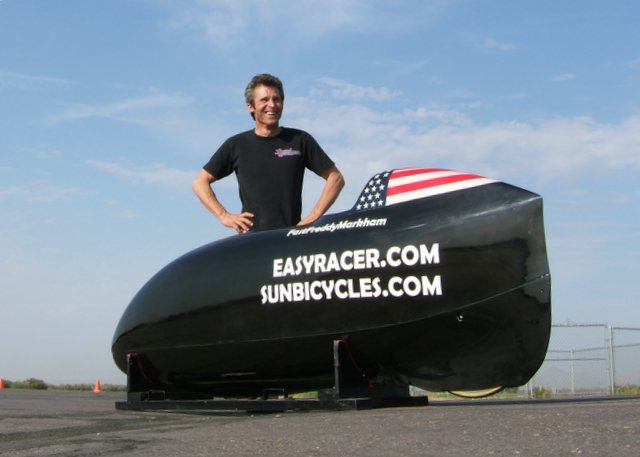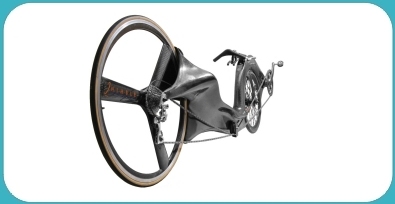The helmet thing keeps popping up in the bike party scene. …In a minor way, but still.
Should people wear a helmet on a bike party ride? …If they want to. Should they comment to others about this? No.
There actually isn’t much of a “helmet war” left in the bike party, social riding scene, thankfully. But it does pop up occasionally. Mostly it’s from those who are peripheral to such riding. Which tells us something. Where do they get the nerve? Who gave them license? This is NOT a PC issue. There is no cross-over that anyone is allowed. You are not speaking up to defend the voiceless against injustice. You are not speaking truth to power. If you hassle someone, you are being stupid.
Anyway, here’s my latest summary. I suppose I have something similar already typed up here but it’s an evergreen… : )
I side with the 99% of world expert lifelong urban social bikers. Millions of city folk who bike as their way of life. Who don’t wear a helmet. So there. That alone takes care of the issue. Don’t talk to me, talk to them, then get back to me. If you think you know better.
Commenting on personal safety in a social setting is patronizing and gauche. It’s rude. Don’t do it.
If you’re involved in some sort of technical theoretical team project, bring it up there.
Note! …Bike helmets aren’t meant to protect from a car-impact. They are designed to help in moderate slip’n’fall scenarios.
And so I refer anyone who remarks on helmets to the walkers and runners and XC skiers they know.
Going on about percentages and statistics in reference to a social outing is LAME. Don’t do it. …Unless someone has signaled to you that they’re cool with it. Otherwise, it’s a buzzkiller for normal people.
If you wanna think safety for some odd reason (what a dull topic!) focus on the car-drivers. Get them to wear helmets. Yeah, side-curtain bags are sweet. Not all cars have em. They don’t always work. Better safe than sorry, right?
Biking already IS safe, people!
I mean, sure, you can get hurt, etc., but c’mon. Who’s afraid of a little blood? Don’t wanna get hurt, learn to tuck’n’roll. If you’re not into that then armor-up, whatever, but don’t blame anything on biking or bike fun!
I suspect that most folks who’ve done bike party rides wouldn’t hassle someone else like I see happening.
I’m not against helmets or performance gear in all cases. That’s clear, right? I shouldn’t have to state the obvious, but this safety topic has been characterized by humorless drones.
When you ride fast, or by yourself in sketchy conditions, armor up! Use whatever equipment that’s needed to get the job done. Recruit various data-generating devices if that’s what YOU like. When in a fast group you better do as they do. Flapping clothes are actually a hazard. Actually, helmets can also be a hazard on a hot, humid day, but whatever the coach says: do it. I’m not talking about that!
I wear a helmet a lot, for all sorts of riding. Lycra jersies, too. Hiviz, even, for sketchy traffic visibility. …But not so much for toodles. That’s just me. Horses for courses. I’m talking about the hassling, scowling, or even earnest reminders that happens. I’m also just wanting to ponder the social impact of these things, of our attitudes to safety, and of our connection to the rest of society. So, please, don’t think I’m against you if you wear a helmet or if you choose to wear hi-viz. Let’s just think about these things a bit, tho… Let’s step back and consider our fashion statement… Let’s look at the trends and their impacts.
So, yeah, you’re being a good role model when you wear a helmet. But is that all? Does an emphasis on function and safety only have one social impact, that of being a good role model? Are you maybe modeling something else as well? Maybe “cyborg”?
I’ve been riding during all the changes after the big bike boom of the 70’s. As each item of high-tech entered the scene, the vibe became more CYBORG and so did the people that cycling was attracting! I was there when lycra first arrived… then when mirrored sunglasses came on and I could no longer see people’s eyes… then when handlebars started having computer consoles… then when first big turtleshell helmets showed up and then later blobular alien helmets arrived… then came hi-viz. Same thing with bike design — bikes looked more and more ‘corporate’ and ‘chemical’. Jersies and shorts got tight and shiny and became louder and less designed. With each change the social impact of cycling changed. …And each step created more BARRIERS between people, between riders, between riders and the public. The kinds of people showing up changed, too. More intense, more athletic, more computery, more coplike, more corporate, with each change that reflected each of those values. It’s been amazing!
Sure, all the improvements can be enjoyed by regular folk in regular ways. But they do also bring the appeal in certain directions which can dominate.
And then bike parties came along. What changes they brought, too! Rusty bikes, city bikes, fixies, 3-speeds, homemade bikes, vintage bikes, tallbikes, sombreros, flannel shirts, dresses, skirts, boomboxes, flipflops, sharing hotdogs and beers. A fresh influx of young people from a wide cross section of town! Holy smokes!
And, remember, not all social rides are alike. It’s a new concept to Americans. So there will be trepidation and lack of familiarity even within social bike scenes. People will throw high-tech at it. People who are already immersed in bike-armoring might start doing social rides. So in some places you’ll see tons of high-tech on a simple toodle. What happens if we take it down a notch?
Around here, the Owosso Peddlers B/C ride has been happening for decades. They get 100+ riders out a couple times a month. They toodle here’n’there around their city. They ride cruisers and rat-rod bikes. DIY specials. Personalized bikes. They have a good time. …No helmets!!! …No lycra! …No neon!
Bike party people firstly are enjoying their contact with their town. And also with motorists! They are not breaking with their fellow man. They aren’t putting in separations.
The helmet question relates to “bike armoring” in general.
Newsflash: bikers don’t have to look ugly.
Car drivers CAN see you if you are somewhat sensible. And they will ALWAYS see a social ride.
Why not wear cheery colors and call it a day.
There is NO need for hi-viz or neon colors in a group! Such colors HURT OUR EYES. They make bikers look OUTLANDISH.
Social rides are slow. They don’t go fast enough to need aero anything. No tight clothes, no bubble sunglasses.
Regular streetwear should be the most common approach to social biking. Wear lycra if all your other clothes are dirty.
Now bikies might just like bikewear. Fine. I’m just saying from a social science view, when casual biking has been normalized most bikers would look normal.
Actually, bikewear is publicly accepted now mostly. I’d have a beer in a bar w/o even taking off my helmet. Who cares. But let’s think bigger.
Social biking is about fitting in and also about social outreach. It’s about making connections with the public.
It’s not about fitness first. It’s about PEOPLE and FUN.
Really, it’s time to TAKE IT TO those who make biking UGLY AND SCOWLY!
What the heck do we think we look like when in a social setting we wear hiviz, an alien-brain hat, reflective bubble sunglasses, anatomically revealing clothes with zero style, and clicky slippery toe-high shoes that make us walk like a penguin? We look out of touch, alienated, segregated, spendy — that’s what!
Sure, the public is tolerant. And nobody really cares. And if you’re behaving normally everything will be fine. I’m just trying to visualize what most biking would look like if it was just a part of society.
Today’s dominant “bike look” attracts whom? Well, sometimes it results in a decent look, but mostly it ends up garishly functional. It’s not attractive, but it attracts people to put it on. And who does that? Wouldn’t it be: mostly Type A bureaucrat technocrat affluent older white bossy people.
Yeah, yeah, lots of normal people do it, too. But realize that this is the socio-psycho direction that the modern bike enthusiast style is taking us!
Yeah, if we commute in the gloom on a busy road we want to armor up and glow like the sun. But would we dress the same if we biked to somebody’s birthday party around the block?
Because biking is NOT yet normal in the USA we mostly get bikers who bike for work or fitness who would NOT ride around the block to a friend’s house. We get serious bikers with lots of serious bikes who’ve never kicked back on a bike. Never biked in a sportcoat to grab a beer. They may well not even consider a 3-speed to be a “serious” bike.
Yeah, yeah, it’s possible to kick back and be mellow in Pro Kit. And intense people are cool, too. But let’s not forget that this is spraypainted cyborg fashion — and that this is its main social impact!
Think about it: bikers mostly do not recognize each other in normal life if they have met them while bike riding “in uniform.” A person in helmet, reflecto shades, garish lycra, clicky shoes bears NO RESEMBLANCE to who they are normally. What does this mean for our sport? Or for its connection to civics? As a sport, sure, it has an identity: a definite look. How well does it relate to normal life and reach out to the general public? There are side effects when apparel religiously worn in public serves to DISGUISE.
Going out even further into social acceptance territory: How do we think today’s bike designs look to people? Bike styling, graphics and paintjobs. My impression is that in most cases both bike apparel and the bikes themselves are hideous. A mash-up of parts, blobular clunky shapes and uninspired paintjobs. So there’s that, too! (Some look great, though — sensible, simple, clean design and color.)
If you want to ride for exercise, go for it. But often the look such people have is unpleasant for others to see, which is why we have gyms, I guess. When I drive through places where fitness biking is happening I am dismayed. It goes beyond helmets and lycra — but it’s related! …All those faces look in pain! They are grinding along grimacing. It’s fine that some people are miserable but we wouldn’t expect social success from a scene with a LOT of people looking that way. It’s like walking: everybody should go out walking every day with their friends for a chat! To see the neighborhood and get a little fresh air. Then, sure, maybe some folks will also pick walking for their sport or some kind of focused effort. But we would see MOST people of a town just out strolling around each day if walking was normal. And the “strident” ones would be a tiny minority. Biking is the same. For biking to succeed MOST bikers have to look like normal people doing something normal. Not straining or exotic.
So, if you want to take a social break after a fast ride or an intense inclement commute, heck, no worries. You look like anyone else hanging out in a work uniform, I suppose. Like a road crew coming into a shop for a break. Looking like a specialist isn’t terrible. It’s what it is.
What kind of social image works best to build connections? Does our “look” affect the potential for biking to grow? What kinds of people does various looks connect with? Who are the demographics that are needed in cycling for it to be relevant? What are our important challenges? Where’s the low-hanging fruit where efforts might have the biggest payoffs?
…Is it in nagging each other for incremental theoretical safety increases?
HAAAA!!!!
I note that I see a “helmet policy” on some social rides. It typically states a helmet is recommended. Why do they have this? Some rides also have a waiver. The only reason they do this is FEAR. Mostly fear of a *paper attack.* Someone might “sue.” Rides that aren’t afraid blow off that jive. How does fear relate to the potential of biking?
Who do we need the most? …Youth, women and minorities.
What is a goal? Bonding between demographics. Helping different people relate to each other, in addition to bringing in different people.
How best to do this? I say: ACT NORMAL! Like regular people.
The normalizing of the bike is key.
Attempts to normalize hideousness, fear, or exotic extremes are stupid. It can be done to an extent but it only attracts limited demographics.
Where is growth in biking today? Is there a scene where a bunch of new people are showing up? What did the past bike boom look like? What kind of biking today is proving that it can interest youth, women and minorities?
Answer: Cheap, casual, fun biking.
Why do young or smart people get involved with anything? Because of ROMANCE! The chance to meet and connect with someone who is attractive in some way. It doesn’t have to mean “dating.” Even in terms of careers or business we want to meet compelling people. …What kind of biking HELPS THIS?
When we see bikers wearing sombreros in the heat we’ll know we’re getting somewhere. When we see bikers riding to a campground on the edge of town after work on Friday with a sleeping bag in their front basket and a guitar across their back then biking has arrived. When we see bikers wearing dresses out in the countryside we’ve made it. …Let all the other kinds of biking add onto that. There’s room for everyone.
Yeah, you can get hurt while biking. …Or while doing ANYTHING.
Don’t talk to me about it.
Watch, look, and learn.
I gave a presentation on social biking scene to a big bike club, one that has a lot of clout and which funds many bike projects, but it’s aging and shrinking. I showed them how social urban biking is the only scene that’s attracting all ages and types of riders, how we’re the only group that’s exploring downtown and cultural events, the only group riding in all weather and at night, how we’re having a great time with local drivers and neighborhood people — the only group reaching out to these folks. …The first remark after my show was: “Why do some riders not have helmets?” I suppose my answer should’ve been a head-slap.
Indeed, the only friction our local social biking has experienced has been not from car drivers or neighbors or cops. We’ve had success in all those areas — maybe ONE negative car honk per summer! No, the only place we’ve gotten friction or *shunning* has been from OTHER BIKERS — self-assumed experts in a kind of biking they haven’t done or organized, or from people with liability fear. Well, people who are uncomfortable not controlling others can move on. Do we need them?




